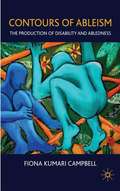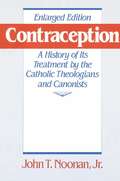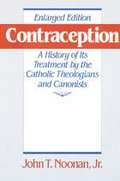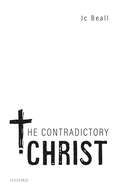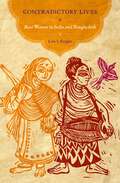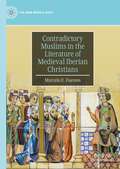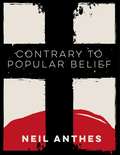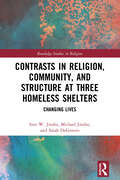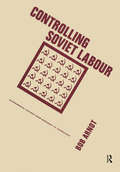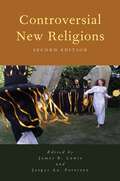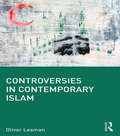- Table View
- List View
Contours Of Ableism: The Production Of Disability And Abledness (PDF)
by Fiona Kumari CampbellChallenging notions of what constitutes 'normal' and 'pathological' bodies, this ambitious, agenda-setting study theoretically reinvigorates disability studies by reconceptualising it as 'studies of ableism' focusing on the practices and formations of able-bodiedness to uncover what it means to be 'able' rather than 'disabled'.
Contraception: A History Of Its Treatment By The Catholic Theologians And Canonists
by John T. Noonan Jr.Originally published in 1965, Contraception received unanimous acclaim from all quarters as the first thorough, scholarly, objective analysis of Catholic doctrine on birth control. More than ever this subject is of acute concern to a world facing serious population problems, and the author has written an important new appendix examining the development of and debates over the doctrine in the past twenty years.
Contraception: A History Of Its Treatment By The Catholic Theologians And Canonists
by John T. Noonan Jr.Originally published in 1965, Contraception received unanimous acclaim from all quarters as the first thorough, scholarly, objective analysis of Catholic doctrine on birth control. More than ever this subject is of acute concern to a world facing serious population problems, and the author has written an important new appendix examining the development of and debates over the doctrine in the past twenty years.
Contract Pastoral Care and Education: The Trend of the Future?
by Larry Van De CreekCreate the Pastoral Care Center that your flock needs!Contract Pastoral Care and Education: The Trend of the Future? provides clergy of all faiths and pastoral care students with insight into the shifting role of chaplains in today's health care environment and explains why many of these positions are disappearing. Examining alternatives to working at hospitals and health care agencies, such as establishing independent contract centers that are commissioned by health care organizations, this book examines the many questions that chaplains are more frequently asking about the stability of their profession. Comprehensive and current, Contract Pastoral Care and Education offers suggestions and models to help you plan your own pastoral care center and continue serving individuals with spiritual care. This honest and informative book contains discussions with chaplains and educators about nine of these care centers in operation, as well as the responses of five chaplains who offer compliments and constructive criticism of these organizations. Exploring the reasons for the decrease in opportunities for pastoral caregivers, such as the decrease of rural populations and the increase of community-based services, Contract Pastoral Care and Education provides you with tips and suggestions that other centers use in order to be effective and successful, including: raising funds from the community, state, and government for operational fees appointing internal, structure-diversified board members who serve without compensation and officers and memberships with specific terms and functions responding to the growing numbers of patients by training lay persons under clinical supervision generating support groups consisting of patients and family members from multiple bereavement groups or organizations to offer comfort and care to othersFull of insight and immediately useful techniques, Contract Pastoral Care and Education will help you keep serving patients and assist you in pursuing a growing facet of the pastoral care field.
Contract Pastoral Care and Education: The Trend of the Future?
by Larry Van De CreekCreate the Pastoral Care Center that your flock needs!Contract Pastoral Care and Education: The Trend of the Future? provides clergy of all faiths and pastoral care students with insight into the shifting role of chaplains in today's health care environment and explains why many of these positions are disappearing. Examining alternatives to working at hospitals and health care agencies, such as establishing independent contract centers that are commissioned by health care organizations, this book examines the many questions that chaplains are more frequently asking about the stability of their profession. Comprehensive and current, Contract Pastoral Care and Education offers suggestions and models to help you plan your own pastoral care center and continue serving individuals with spiritual care. This honest and informative book contains discussions with chaplains and educators about nine of these care centers in operation, as well as the responses of five chaplains who offer compliments and constructive criticism of these organizations. Exploring the reasons for the decrease in opportunities for pastoral caregivers, such as the decrease of rural populations and the increase of community-based services, Contract Pastoral Care and Education provides you with tips and suggestions that other centers use in order to be effective and successful, including: raising funds from the community, state, and government for operational fees appointing internal, structure-diversified board members who serve without compensation and officers and memberships with specific terms and functions responding to the growing numbers of patients by training lay persons under clinical supervision generating support groups consisting of patients and family members from multiple bereavement groups or organizations to offer comfort and care to othersFull of insight and immediately useful techniques, Contract Pastoral Care and Education will help you keep serving patients and assist you in pursuing a growing facet of the pastoral care field.
Contracts and Deals in Islamic Finance: A User's Guide to Cash Flows, Balance Sheets, and Capital Structures (Wiley Finance)
by Hussein Kureshi Mohsin HayatA very accessible and concise guide to Islamic finance Contracts and Deals in Islamic Finance provides a clear breakdown of Islamic financial contracts and deal structures for beginners. The embedded requirements within selected Islamic financial contracts, such as risk weightage, capital structures, creations of cash flows, and balance sheets, are explained fully to provide a solid understanding of the backbone of the industry. Aimed primarily at beginners and those with a background in conventional banking, this book guides readers through the major contracts, how they're applied, and how to discern a contract's legitimacy. Case studies and interviews with bankers and global regulators provide real-life examples of contract application, and the author's own experiences provide deep insight into the everyday issues that arise. Ancillary instructor's materials include PowerPoint slides and lecture notes that facilitate use in the classroom. Literature describing the application of Islamic financial contracts is few and far between, and those providing a basic breakdown of these contracts and questioning their validity are rarer still. This book is the first of its kind, offering a basic approach to understanding Islamic contracts, designed for the true beginner. Understand the current contracts applied in Islamic banking Learn how contracts are applied across different jurisdictions Identify illegitimate contracts and those not in the spirit of Shariah law Examine the current economic realities surrounding Islamic finance By highlighting the underlying themes in Islamic finance and assessing the current practices, this book gives readers the solid understanding and up-to-date perspective that form a solid foundation upon which successful Islamic finance is practiced. For a solid introduction to the Islamic finance industry, Contracts and Deals in Islamic Finance is an accessible, practical guide.
Contracts and Deals in Islamic Finance: A User's Guide to Cash Flows, Balance Sheets, and Capital Structures (Wiley Finance)
by Hussein Kureshi Mohsin HayatA very accessible and concise guide to Islamic finance Contracts and Deals in Islamic Finance provides a clear breakdown of Islamic financial contracts and deal structures for beginners. The embedded requirements within selected Islamic financial contracts, such as risk weightage, capital structures, creations of cash flows, and balance sheets, are explained fully to provide a solid understanding of the backbone of the industry. Aimed primarily at beginners and those with a background in conventional banking, this book guides readers through the major contracts, how they're applied, and how to discern a contract's legitimacy. Case studies and interviews with bankers and global regulators provide real-life examples of contract application, and the author's own experiences provide deep insight into the everyday issues that arise. Ancillary instructor's materials include PowerPoint slides and lecture notes that facilitate use in the classroom. Literature describing the application of Islamic financial contracts is few and far between, and those providing a basic breakdown of these contracts and questioning their validity are rarer still. This book is the first of its kind, offering a basic approach to understanding Islamic contracts, designed for the true beginner. Understand the current contracts applied in Islamic banking Learn how contracts are applied across different jurisdictions Identify illegitimate contracts and those not in the spirit of Shariah law Examine the current economic realities surrounding Islamic finance By highlighting the underlying themes in Islamic finance and assessing the current practices, this book gives readers the solid understanding and up-to-date perspective that form a solid foundation upon which successful Islamic finance is practiced. For a solid introduction to the Islamic finance industry, Contracts and Deals in Islamic Finance is an accessible, practical guide.
Contradiction in the Book of Proverbs: The Deep Waters of Counsel (Society for Old Testament Study)
by Peter HattonDespite the welcome revival of scholarly interest in Biblical Wisdom, the Book of Proverbs remains neglected. It continues to be seen as a disorganised repository of traditional banalities, while Job and Qohelet are viewed as more exciting texts, in revolt against Proverbs' conventional wisdom. Contradiction in the Book of Proverbs argues that this misleading consensus owes more to scholarly presuppositions than to the content of Proverbs; it sees Proverbs as a challenging work, one that aims to provoke a critical appropriation of wisdom and in which diverse sources have been skilfully brought together by a creative final editor to form a complex unity. Many divergences from the Hebrew in the Greek witness to the translator's discomfort with his spikey, provocative original. Peter Hatton challenges many existing scholarly assumptions and calls for a re-evaluation of the role and significance of Proverbs in relation to the other biblical wisdom books and the whole canon.
Contradiction in the Book of Proverbs: The Deep Waters of Counsel (Society for Old Testament Study)
by Peter HattonDespite the welcome revival of scholarly interest in Biblical Wisdom, the Book of Proverbs remains neglected. It continues to be seen as a disorganised repository of traditional banalities, while Job and Qohelet are viewed as more exciting texts, in revolt against Proverbs' conventional wisdom. Contradiction in the Book of Proverbs argues that this misleading consensus owes more to scholarly presuppositions than to the content of Proverbs; it sees Proverbs as a challenging work, one that aims to provoke a critical appropriation of wisdom and in which diverse sources have been skilfully brought together by a creative final editor to form a complex unity. Many divergences from the Hebrew in the Greek witness to the translator's discomfort with his spikey, provocative original. Peter Hatton challenges many existing scholarly assumptions and calls for a re-evaluation of the role and significance of Proverbs in relation to the other biblical wisdom books and the whole canon.
The Contradictory Christ (Oxford Studies in Analytic Theology)
by Jc BeallIn this ground-breaking study, Jc Beall shows that the fundamental "problem" of Christology is simple to see from the role that Christ occupies: the Christ figure is to have the divine and essentially limitless properties of the one and only God but Christ is equally to have the human, essentially limit-imposing properties involved in human nature, limits essentially involved in being human. The role that Christ occupies thereby appears to demand a contradiction: all of the limitlessness of God, and all of the limits of humans. This book lays out Beall's contradictory account of Jesus Christ — and thereby a contradictory Christian theology.
The Contradictory Christ (Oxford Studies in Analytic Theology)
by Jc BeallIn this ground-breaking study, Jc Beall shows that the fundamental "problem" of Christology is simple to see from the role that Christ occupies: the Christ figure is to have the divine and essentially limitless properties of the one and only God but Christ is equally to have the human, essentially limit-imposing properties involved in human nature, limits essentially involved in being human. The role that Christ occupies thereby appears to demand a contradiction: all of the limitlessness of God, and all of the limits of humans. This book lays out Beall's contradictory account of Jesus Christ — and thereby a contradictory Christian theology.
Contradictory Lives: Baul Women in India and Bangladesh
by Lisa I. KnightIn literature and popular imagination, the Bauls of India and Bangladesh are characterized as musical mystics: orange-clad nomads of both Hindu and Muslim backgrounds. They wander the countryside and entertain with their passionate singing and unusual behavior, and they are especially well-known for their evocative songs, which challenge the caste system and sectarianism prevalent in South Asia. Although Bauls claim to value women over men, little is known about the individual views and experiences of Baul women. Based on ethnographic research in both the predominantly Hindu context of West Bengal (India) and the Muslim country of Bangladesh, this book explores the everyday lives of Baul women. Lisa Knight examines the contradictory expectations regarding Baul women: on the one hand, the ideal of a group unencumbered by societal restraints and concerns and, on the other, the real constraints of feminine respectability that seemingly curtail women's mobility and public performances. Knight demonstrates that Baul women respond to these conflicting expectations in various ways, sometimes adopting and other times subverting local gendered norms to craft meaningful lives. More so than their male counterparts, Baul women feel encumbered by norms. But rather than seeing Baul women's normative behavior as indicative of their conformity to gendered roles (and, therefore, failures as Bauls), Knight argues that these women creatively draw on societal expectations to transcend their social limits and create new paths.
Contradictory Muslims in the Literature of Medieval Iberian Christians (The New Middle Ages)
by Marcelo E. FuentesThis book argues that literary and historiographical works written by Iberian Christians between the twelfth and sixteenth centuries promoted contradictory representations of Muslims in order to advocate for their colonization through the affirmation of Christian supremacy. Ambivalent depictions of cultural difference are essential for colonizers to promote their own superiority, as explained by postcolonial critics and observed in medieval and early modern texts in Castilian, Catalan, and Portuguese, such as the Cantar de mio Cid, Cantigas de Santa Maria, Llibre dels fets, Estoria de España, Crónica geral de 1344, Tirant lo Blanch, and Os Lusíadas. In all these works, the contradictions of Muslim enemies, allies, and subjects allow Christian leaders to prevail and profit through their opposition and collaboration with them. Such colonial dynamics of simultaneous belligerence and assimilation determined the ways in which Portugal, Spain, and later European powers interacted with non-Christians in Africa, Asia, and even the Americas.
Contrary Thinking: Selected Essays of Daya Krishna
by Daya KrishnaDaya Krishna (1924-2007) was easily the most creative and original Indian philosopher of the second half of the 20th century. His thought and philosophical energy dominated academic Indian philosophy and determined the nature of the engagement of Indian philosophy with Western philosophy during that period. He passed away recently, leaving behind an enormous corpus of published work on a wide range of philosophical topics, as well as a great deal of incomplete, nearly-complete and complete-but-as-yet-unpublished work. Daya Krishna's thought and publications address a broad range of philosophical issues, including issues of global philosophical importance that transcend considerations of particular traditions; issues particular to Indian philosophy; and issues at the intersection of Indian and Western philosophy, especially questions about the philosophy of language and ontology that emerge in the context of his Samvada project that brought together Western philosophers and Nyaya pandits to discuss questions in the philosophy of language and metaphysics. The volume editors have organized the volume as a set of ten couplets and triplets. Each draws together papers from different periods in Daya Krishna's life: some take different approaches to the same problem or text; in some cases, the second paper references and takes issue with arguments developed in the first; in still others, Daya Krishna addresses very different topics, but using the same distinctive philosophical methodology. Each set is introduced by one of the editors. These couplets are framed by two of Daya Krishna's finest metaphilosophical essays, one that introduces his approach, and one that draws some of his grand morals about the discipline. Daya Krishna's daughter, Professor Shail Mayaram of the Center for the Study of Developing Societies contributes a preface, and Professor Arindam Chakrabarti, a longtime colleague of Daya Krisha and a collaborator on some of his most important philosophical ventures has written the introduction.
Contrary to Popular Belief
by Neil AnthesDid early Christianity evolve from Roman culture and customs? Was it based on truth?Were the social issues of the early Roman Empire a driving force to adapt old customs to a new philosophy?A young Hebrew man seeks answers beyond his religious traditions by spending fifteen years travelling and studying spiritual principles in India and Alexandria, Egypt. Upon returning to his homeland his message of self-awareness is feared by the elders and Temple priests.At the same time the ruling elite in Rome are determined to use this controversy to their advantage. Keen to find a solution to the social and economic issues that have developed after their relentless conquests of foreign lands, they find that the young man's spiritual message can be altered to suit their needs.Contrary to Popular Belief is a thought-provoking novel inspired by Christian faith, and the quest for truth.
Contrasts in Religion, Community, and Structure at Three Homeless Shelters: Changing Lives (Routledge Studies in Religion)
by Michael Jindra Ines W. Jindra Sarah DeGeneroHow do people in poverty and homelessness change their lives and get back on their feet? Homeless shelters across the world play a huge role in this process. Many of them are religious, but there is a lot of diversity in faith-based non-profits that assist people affected by poverty and homelessness. In this timely book, the authors look at three homeless shelters that take more or less intensive approaches to faith, community, and programming. In one shelter, for instance, residents are required to do a program of classes that includes group Bible study, worship, and self-evaluation. The other two examined are significantly less faith-based, but in different ways and with different structures. The authors show how the three shelters tackle homelessness differently, drawing on narrative biographical interviews and case studies with residents, interviews with staff, and case study research of the three shelters. Entering into significant debates in social theory over religion, agency, cognitive action, and culture, this book is important reading for scholars and students in religious studies, sociology and social work.
Contrasts in Religion, Community, and Structure at Three Homeless Shelters: Changing Lives (Routledge Studies in Religion)
by Michael Jindra Ines W. Jindra Sarah DeGeneroHow do people in poverty and homelessness change their lives and get back on their feet? Homeless shelters across the world play a huge role in this process. Many of them are religious, but there is a lot of diversity in faith-based non-profits that assist people affected by poverty and homelessness. In this timely book, the authors look at three homeless shelters that take more or less intensive approaches to faith, community, and programming. In one shelter, for instance, residents are required to do a program of classes that includes group Bible study, worship, and self-evaluation. The other two examined are significantly less faith-based, but in different ways and with different structures. The authors show how the three shelters tackle homelessness differently, drawing on narrative biographical interviews and case studies with residents, interviews with staff, and case study research of the three shelters. Entering into significant debates in social theory over religion, agency, cognitive action, and culture, this book is important reading for scholars and students in religious studies, sociology and social work.
Controlling Soviet Labour
by ArnotWith a growing population, deteriorating economic conditions, and an unstable imperial centre, Soviet Central Asia would seem destined to become a trouble spot. Instead Islamic traditionalism has survived and flourished in Central Asia. This book looks at the reasons why.
Controlling Soviet Labour: Experimental Change From Brezhnev To Gorbachev
by ArnotWith a growing population, deteriorating economic conditions, and an unstable imperial centre, Soviet Central Asia would seem destined to become a trouble spot. Instead Islamic traditionalism has survived and flourished in Central Asia. This book looks at the reasons why.
Controversial New Religions
by James R. Lewis and Jesper Aa. PetersenIn terms of public opinion, new religious movements are considered controversial for a variety of reasons. Their social organization often runs counter to popular expectations by experimenting with communal living, alternative leadership roles, unusual economic dispositions, and new political and ethical values. As a result the general public views new religions with a mixture of curiosity, amusement, and anxiety, sustained by lavish media emphasis on oddness and tragedy rather than familiarity and lived experience. This updated and revised second edition of Controversial New Religions offers a scholarly, dispassionate look at those groups that have generated the most attention, including some very well-known classical groups like The Family, Unification Church, Scientology, and Jim Jones's People's Temple; some relative newcomers such as the Kabbalah Centre, the Order of the Solar Temple, Branch Davidians, Heaven's Gate, and the Falun Gong; and some interesting cases like contemporary Satanism, the Raelians, Black nationalism, and various Pagan groups. Each essay combines an overview of the history and beliefs of each organization or movement with original and insightful analysis. By presenting decades of scholarly work on new religious movements written in an accessible form by established scholars as well as younger experts in the field, this book will be an invaluable resource for all those who seek a view of new religions that is deeper than what can be found in sensationalistic media stories.
Controversial New Religions
In terms of public opinion, new religious movements are considered controversial for a variety of reasons. Their social organization often runs counter to popular expectations by experimenting with communal living, alternative leadership roles, unusual economic dispositions, and new political and ethical values. As a result the general public views new religions with a mixture of curiosity, amusement, and anxiety, sustained by lavish media emphasis on oddness and tragedy rather than familiarity and lived experience. This updated and revised second edition of Controversial New Religions offers a scholarly, dispassionate look at those groups that have generated the most attention, including some very well-known classical groups like The Family, Unification Church, Scientology, and Jim Jones's People's Temple; some relative newcomers such as the Kabbalah Centre, the Order of the Solar Temple, Branch Davidians, Heaven's Gate, and the Falun Gong; and some interesting cases like contemporary Satanism, the Raelians, Black nationalism, and various Pagan groups. Each essay combines an overview of the history and beliefs of each organization or movement with original and insightful analysis. By presenting decades of scholarly work on new religious movements written in an accessible form by established scholars as well as younger experts in the field, this book will be an invaluable resource for all those who seek a view of new religions that is deeper than what can be found in sensationalistic media stories.
Controversial Reasoning in Indian Philosophy: Major Texts and Arguments on Arthâpatti
by Edited by Malcolm KeatingArthâpatti is a pervasive form of reasoning investigated by Indian philosophers in order to think about unseen causes and interpret ordinary and religious language. Its nature is a point of controversy among Mimamsa, Nyaya, and Buddhist philosophers, yet, to date, it has received less attention than perception, inference, and testimony. This collection presents a one-of-a-kind reference resource for understanding this form of reasoning studied in Indian philosophy. Assembling translations of central primary texts together with newly-commissioned essays on research topics, it features a significant introductory essay. Readable translations of Sanskrit works are accompanied by critical notes that introduce arthâpatti, offer historical context, and clarify the philosophical debates surrounding it.Showing how arthâpatti is used as a way to reason about the basic unseen causes driving language use, cause-and-effect relationships, as well as to interpret ambiguous or figurative texts, this book demonstrates the importance of this epistemic instrument in both contemporary Anglo-analytic and classical Indian epistemology, language, and logic.
Controversial Reasoning in Indian Philosophy: Major Texts and Arguments on Arthâpatti
Arthâpatti is a pervasive form of reasoning investigated by Indian philosophers in order to think about unseen causes and interpret ordinary and religious language. Its nature is a point of controversy among Mimamsa, Nyaya, and Buddhist philosophers, yet, to date, it has received less attention than perception, inference, and testimony. This collection presents a one-of-a-kind reference resource for understanding this form of reasoning studied in Indian philosophy. Assembling translations of central primary texts together with newly-commissioned essays on research topics, it features a significant introductory essay. Readable translations of Sanskrit works are accompanied by critical notes that introduce arthâpatti, offer historical context, and clarify the philosophical debates surrounding it.Showing how arthâpatti is used as a way to reason about the basic unseen causes driving language use, cause-and-effect relationships, as well as to interpret ambiguous or figurative texts, this book demonstrates the importance of this epistemic instrument in both contemporary Anglo-analytic and classical Indian epistemology, language, and logic.
A Controversial Spirit: Evangelical Awakenings in the South (Religion in America)
by Philip N. MulderA Controversial Spirit offers a new perspective on the origins and nature of southern evangelicalism. Most recent historians have focused on the differences between evangelicals and non-evangelicals. This has led to the perception that during the "Era of Awakenings" (mid-18th and early 19th century) American evangelicals constituted a united front. Philip N. Mulder dispels this illusion, by examining the internal dynamics of evangelicalism. He focuses on the relationships among the Presbyterians, Baptists, and Methodists who introduced the new religious mood to the South between 1740 and 1820. Although the denominations shared the goal of saving souls, he finds, they disagreed over the correct definition of true religion and conversion. The Presbyterians and Baptists subordinated the freedom, innovation and experience of the awakenings to their particular denominational concerns. The Methodists, on the other hand, were more aggressive and innovative advocates of the New Light awakenings. They broke through the insularity of the other two groups and revolutionized the religious culture of the emerging nation. The American Revolution exacerbated the growing competition and jealousy among the denominations by displacing their common enemy, the established Anglican church. Former dissenters now turned to face each other. Free religious competition was transformative, Mulder argues. The necessity of competing for converts forced the Presbyterians and Baptists out of their narrow confines. More importantly, however, competition compromised the Methodists and their New Light ideals. Methodists had presented themselves as an ecumenical alternative to the rigid and rancorous denominations of England and America. Now they turned away from their open message of salvation, and began using their distinctive characteristics to separate themselves from other denominations. The Methodists thus succumbed to the evangelical pattern set by others - a pattern of distinction, insularity, and divisive competition. Examining conversion narratives, worship, polity, and rituals, as well as more formal doctrinal statements in creeds and sermons, Mulder is able to provide a far more nuanced portrait of southern evangelicals than previously available, revealing the deep differences between denominations that the homogenization of religious history has until now obscured.
Controversies in Contemporary Islam
by Oliver LeamanThis book helps to deepen our understanding of the varieties of contemporary Islam and the issues that are of most concern to Muslims today. Oliver Leaman explores some of the controversies and debates that exist within Islam and between Islam and other religions. He considers how the religion can be defined by looking at the contrast between competing sets of beliefs, and arguments amongst Muslims themselves over the nature of the faith. Areas covered include: Qur’anic interpretation, gender, finance, education, and nationalism. Examples are taken from a range of contexts and illustrate the diversity of approaches to Islam that exists today.
